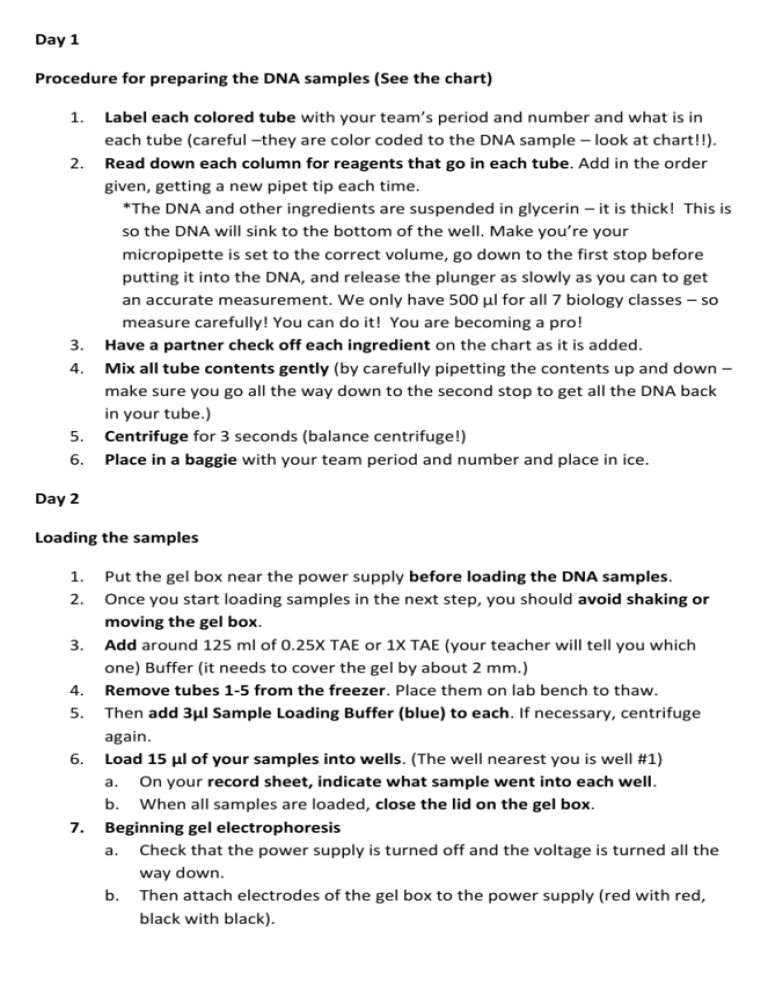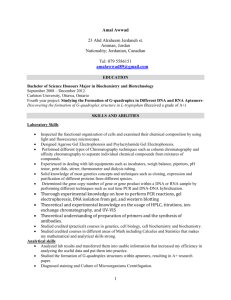Day 1 Procedure for preparing the DNA samples (See the chart
advertisement

Day 1 Procedure for preparing the DNA samples (See the chart) 1. 2. 3. 4. 5. 6. Label each colored tube with your team’s period and number and what is in each tube (careful –they are color coded to the DNA sample – look at chart!!). Read down each column for reagents that go in each tube. Add in the order given, getting a new pipet tip each time. *The DNA and other ingredients are suspended in glycerin – it is thick! This is so the DNA will sink to the bottom of the well. Make you’re your micropipette is set to the correct volume, go down to the first stop before putting it into the DNA, and release the plunger as slowly as you can to get an accurate measurement. We only have 500 µl for all 7 biology classes – so measure carefully! You can do it! You are becoming a pro! Have a partner check off each ingredient on the chart as it is added. Mix all tube contents gently (by carefully pipetting the contents up and down – make sure you go all the way down to the second stop to get all the DNA back in your tube.) Centrifuge for 3 seconds (balance centrifuge!) Place in a baggie with your team period and number and place in ice. Day 2 Loading the samples 1. 2. 3. 4. 5. 6. 7. Put the gel box near the power supply before loading the DNA samples. Once you start loading samples in the next step, you should avoid shaking or moving the gel box. Add around 125 ml of 0.25X TAE or 1X TAE (your teacher will tell you which one) Buffer (it needs to cover the gel by about 2 mm.) Remove tubes 1-5 from the freezer. Place them on lab bench to thaw. Then add 3µl Sample Loading Buffer (blue) to each. If necessary, centrifuge again. Load 15 µl of your samples into wells. (The well nearest you is well #1) a. On your record sheet, indicate what sample went into each well. b. When all samples are loaded, close the lid on the gel box. Beginning gel electrophoresis a. Check that the power supply is turned off and the voltage is turned all the way down. b. Then attach electrodes of the gel box to the power supply (red with red, black with black). c. 8. 9. If sharing a power supply, just turn off the power supply while connecting the second gel box. d. Adjust the power supply to either 100 volts or 200 volts (ask your teacher) Record the following information in your journal: Record start time, total electrophoresis time, voltage and current (may change during the run). Running the gel a. Electrophorese for 20 minutes at 200 volts or 45 minutes at 100 volts (again, ask your teacher). Less time will result in poor separation of DNA bands. b. You can monitor the progress of the electrophoresis by watching the tracking dyes included in the sample loading buffer, bromophenol blue (purple) and xylene cyanol. It’s best to run the gels until the bromophenol blue has moved about 2/3 of the way through the gel (or halfway if time is short.) Stain and destain the gel using FastBlast™ Stain 10. Stain: Following electrophoresis, the gel will be much more delicate than the one we used in the dye lab. Carefully place the gel into a staining tray. (Cover the gel with 30 ml of 100X FastBlast™ and allow it to sit for 3 minutes. Pour the stain into the used FastBlast™ container (stain can be reused 7 times). 11. Destain: Transfer the gel to a large container and rinse it with 500 ml of warm (40-55 degree C) tap water for 10 seconds. Discard the water. Again, add 500 ml of warm tap water and agitate (rock side to side) gently for 5 minutes. Discard the water and repeat 5 minute wash in warm water. Discard the final wash and observe results. 12. Store: Once destained, the gel can be put into a plastic baggie and stored in the refrigerator (your teacher will tell you where to place finished gels). If you still have lots of blue stain in the gel, your teacher may suggest you add a little water to the bag to destain overnight. Day 1 Procedure for preparing the DNA samples (See the chart) 1. 2. 3. 4. 5. 6. Label each colored tube with your team’s period and number and what is in each tube (careful –they are color coded to the DNA sample – look at chart!!). Read down each column for reagents that go in each tube. Add in the order given, getting a new pipet tip each time. *The DNA and other ingredients are suspended in glycerin – it is thick! This is so the DNA will sink to the bottom of the well. Make you’re your micropipette is set to the correct volume, go down to the first stop before putting it into the DNA, and release the plunger as slowly as you can to get an accurate measurement. We only have 500 µl for all 7 biology classes – so measure carefully! You can do it! You are becoming a pro! Have a partner check off each ingredient on the chart as it is added. Mix all tube contents gently (by carefully pipetting the contents up and down – make sure you go all the way down to the second stop to get all the DNA back in your tube.) Centrifuge for 3 seconds (balance centrifuge!) Place in a baggie with your team period and number and place in ice. Day 2 Loading the samples 1. 2. 3. 4. 5. 6. 7. Put the gel box near the power supply before loading the DNA samples. Once you start loading samples in the next step, you should avoid shaking or moving the gel box. Add around 125 ml of 0.25X TAE or 1X TAE (your teacher will tell you which one) Buffer (it needs to cover the gel by about 2 mm.) Remove tubes 1-5 from the freezer. Place them on lab bench to thaw. Then add 3µl Sample Loading Buffer (blue) to each. If necessary, centrifuge again. Load 15 µl of your samples into wells. (The well nearest you is well #1) a. On your record sheet, indicate what sample went into each well. b. When all samples are loaded, close the lid on the gel box. Beginning gel electrophoresis a. Check that the power supply is turned off and the voltage is turned all the way down. b. Then attach electrodes of the gel box to the power supply (red with red, black with black). c. 8. 9. If sharing a power supply, just turn off the power supply while connecting the second gel box. d. Adjust the power supply to either 100 volts or 200 volts (ask your teacher) Record the following information in your journal: Record start time, total electrophoresis time, voltage and current (may change during the run). Running the gel a. Electrophorese for 20 minutes at 200 volts or 45 minutes at 100 volts (again, ask your teacher). Less time will result in poor separation of DNA bands. b. You can monitor the progress of the electrophoresis by watching the tracking dyes included in the sample loading buffer, bromophenol blue (purple) and xylene cyanol. It’s best to run the gels until the bromophenol blue has moved about 2/3 of the way through the gel (or halfway if time is short.) Stain and destain the gel using FastBlast™ Stain 10. Stain: Following electrophoresis, the gel will be much more delicate than the one we used in the dye lab. Carefully place the gel into a staining tray. (Cover the gel with 30 ml of 100X FastBlast™ and allow it to sit for 3 minutes. Pour the stain into the used FastBlast™ container (stain can be reused 7 times). 11. Destain: Transfer the gel to a large container and rinse it with 500 ml of warm (40-55 degree C) tap water for 10 seconds. Discard the water. Again, add 500 ml of warm tap water and agitate (rock side to side) gently for 5 minutes. Discard the water and repeat 5 minute wash in warm water. Discard the final wash and observe results. 12. Store: Once destained, the gel can be put into a plastic baggie and stored in the refrigerator (your teacher will tell you where to place finished gels). If you still have lots of blue stain in the gel, your teacher may suggest you add a little water to the bag to destain overnight.


![Student Objectives [PA Standards]](http://s3.studylib.net/store/data/006630549_1-750e3ff6182968404793bd7a6bb8de86-300x300.png)




